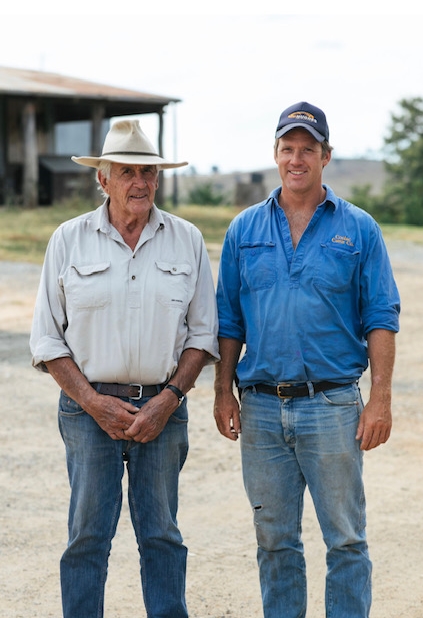 Bobby Miller (right) with his dad Jim Miller (left).
Bobby Miller (right) with his dad Jim Miller (left).
When it comes to improving ground cover management to ensure pastures recover quickly after a dry time, the MLA-sponsored Coolac Healthy Soils Program has been a game changer for NSW producer Bobby Miller.
With assistance from farm manager, John Girdler, Bobby and his wife Matilda operate their 4,250ha family property 'Cooininee', south of Jugiong, NSW, on the banks of the Murrumbidgee River.
Cooininee comprises granite hill country running down to alluvial flats, with small pockets of basalt and main pasture species including phalaris and clover on the sloping country, lucerne on the most trafficable areas and native pastures on the non-arable sections.
With an average rainfall of 650mm, the property is run as a beef and sheep grazing enterprise. While 70% of the business is an Angus breeder operation, with steers taken through to feedlot weight and most heifers retained and joined, the other 30% is a self-replacing prime lamb enterprise.
Speeding up soil recovery
For Bobby, taking part in the local Healthy Soils Program was driven by his desire to find ways to get his country to recover faster after frequent periods of low rainfall.
"When we went into the drought, we were as heavily stocked as we had ever been before, and I was probably too slow in destocking or locking up and feeding," Bobby said.
"The result of that was a lot of overgrazed, bare country, which really came to bite us when we did get rain because it was very slow to recover."
"We had soil compaction and low ground cover, so that the rain that was falling would evaporate or run off quite quickly and not get the opportunity to penetrate."
Through Healthy Soils, Bobby learnt about ground cover management skills and tools that he says will help improve his feedbase management through the variable seasons.
"One of the workshop sessions was all about ground cover and how to measure that using a grid method before you get your eye in with the grid and you can assess freehand," Bobby said.
"That workshop has guided us and we're now trying to keep 100% ground cover."
Going for ground cover
In an attempt to maintain ground cover on Cooininee, Bobby and John are now removing livestock from pastures much earlier when conditions start to dry off, as well as further developing their drought-lot.
With the current dry conditions at Cooininee, all sheep are being held in the drought-lot, and fed a maintenance ration, to avoid bearing out pastures.
"We decided to do this to keep as much of the ground cover and leaf area there as we can, for when the break comes along," Bobby said.
These efforts to maintain solid ground cover paid off earlier this year when the property weathered 220mm of rain in just 24 hours with minimal damage.
"There was certainly a lot less damage, run-off and soil loss than there had been in previous summers," Bobby said.
Soil testing in action
One of the other aspects of the Healthy Soils Program Bobby found particularly useful was the opportunity to analyse soil test results.
Soils specialist Jason Condon from the NSW Department of Primary Industries interpreted the soil test data, giving context around each of the readings, explaining how they interrelate and providing guidance on critical nutrient values.
As well as the theory, the group also learnt practical field techniques, such as how to determine the clay content of soils using the ribbon test method.
This knowledge has enabled Bobby to set effective targets for his fertiliser program, with particular emphasis on achieving critical phosphorus levels, as well as assess and understand soil type and performance – skills he said have helped solve pasture problems on-farm.
"It all goes into the problem-solving matrix – I try to be informed, so that when I go to the agronomist, I have got a parcel of information for him to figure out, rather than just getting him to do all the work," Bobby said.
"I like to understand what the problem is and what the solution is."
"A lot of the information from the workshop has helped guide that development of knowledge and understanding."






